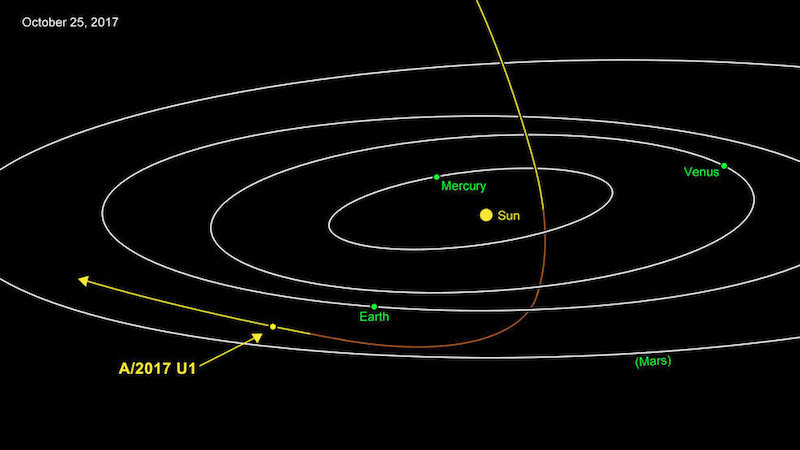 A/2017 U1 is most likely of interstellar origin. Approaching from above, it was closest to the Sun on Sept. 9. Traveling at 27 miles per second (44 kilometers per second), the comet is headed away from the Earth and Sun on its way out of the solar system. Credits: NASA/JPL-Caltech
A/2017 U1 is most likely of interstellar origin. Approaching from above, it was closest to the Sun on Sept. 9. Traveling at 27 miles per second (44 kilometers per second), the comet is headed away from the Earth and Sun on its way out of the solar system. Credits: NASA/JPL-Caltech
Oct. 26, 2017 (Phys.org) -- A small, recently discovered asteroid -- or perhaps a comet -- appears to have originated from outside the solar system, coming from somewhere else in our galaxy.
If so, it would be the first "interstellar object" to be observed and confirmed by astronomers.
This unusual object -- for now designated A/2017 U1 -- is less than a quarter-mile (400 meters) in diameter and is moving remarkably fast. Astronomers are urgently working to point telescopes around the world and in space at this notable object. Once these data are obtained and analyzed, astronomers may know more about the origin and possibly the composition of the object.
A/2017 U1 was discovered Oct. 19 by the University of Hawaii's Pan-STARRS 1 telescope on Haleakala during the course of its nightly search for Near-Earth Objects for NASA. Rob Weryk, a postdoctoral researcher at the University of Hawaii Institute for Astronomy (IfA), was first to identify the moving object and submit it to the Minor Planet Center. Weryk subsequently searched the Pan-STARRS image archive and found it was present in images taken the previous night, but was not initially identified by the moving object processing.
Weryk immediately realized this was an unusual object. "Its motion could not be explained using either a normal solar system asteroid or comet orbit," he said. Weryk contacted IfA graduate Marco Micheli, who had the same realization using his own follow-up images taken at the European Space Agency's telescope on Tenerife in the Canary Islands. But with the combined data, everything made sense. Said Weryk, "This object came from outside our solar system."
(more)
READ MORE: Phys.org





